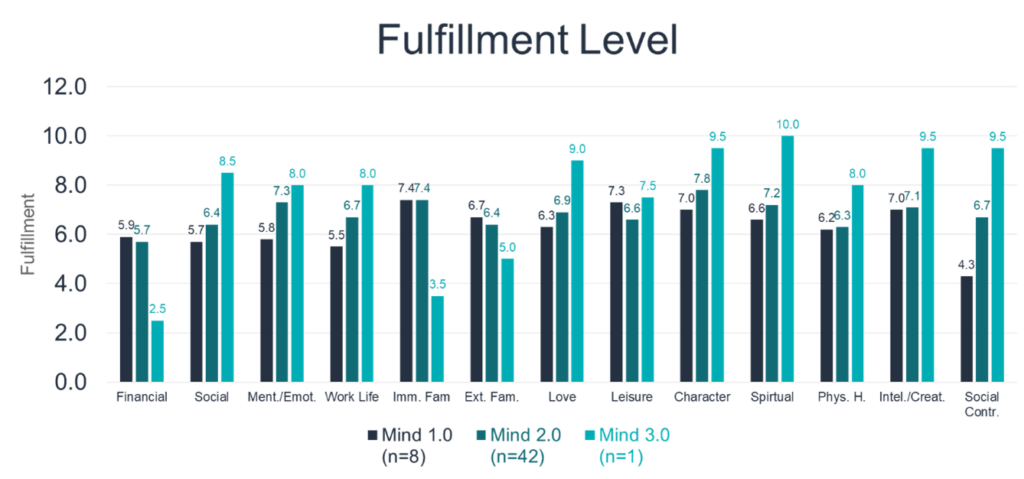Do people at higher vertical development altitudes experience greater life fulfillment?
That is a question that I partnered with Maurice Thibodeau to answer.
Maurice is a the creator of a fantastic self-assessment called the Life Inventory Assessment, which is designed to help people gauge the degree to which they are fulfilled in their life across 13 different life categories, including financial, social, mental/emotional, work life, etc.
I am the creator of a Vertical Development Assessment. This assessment is designed to help people identify the quality and sophistication of their internal operating system. Adult development psychology has found that people generally operate from one of three levels of adult development. I call them:
- Mind 1.0 – Good Soldier Mode – Our body is programmed to seek safety, comfort, and belonging – At this level, we largely operate as dependent thinkers
- Mind 2.0 – Progress Maker Mode – Our body is programmed to seek standing out, advancing, and getting ahead – At this level, we largely operate as independent thinkers
- Mind 3.0 – Value Creator Mode – Our body is programmed to contribute, add value, and lift others – At this level, we largely operate as interdependent thinkers
What we know about these three vertical development levels is that as people elevate, they:
- Develop wider windows of tolerance
- Are able to stay more regulated
- Make healthier life choices
- Have a greater positive impact on their spheres of influence
- Are more effective at developing and maintaining relationships with others
Knowing this, Maurice hypothesized that people at higher vertical development altitudes have greater life fulfillment. And, we invited people to complete both of our assessments so we could explore if people who operate at higher vertical development altitudes are actually more fulfilled in their life.
I want to share the preliminary results from our efforts and analysis.
I state preliminary because we really need a larger sample size, particularly people who fall in the Mind 1.0 and Mind 3.0 levels. We only had one person at the Mind 3.0 level, and it is difficult to generalize the findings of one person to the population of Mind 3.0 people.
Specifically, we had 51 people complete both assessments, which broke down as follows:
- Mind 1.0 – 8 people (16%)
- Mind 2.0 – 42 people (82%)
- Mind 3.0 – 1 person (2%)
When researchers have assessed the breakdown of executives and leaders in organizations, they have found that:
- 7% operate at Mind 1.0
- 85% operate at Mind 2.0
- 1% operate at Mind 3.0.
Thus, our sample seems to be a more professional group than the general public, and they map on closely to what Robert Kegan found in his research.
Our Findings
First, we looked at overall fulfillment by Mind Level:

Maurice informed me that while we see the step-up relationship we expected, he expected to see greater differences between the different Mind Levels. (FYI – We currently don’t have the sample size to determine if these differences are statistically significant.)
Next, we looked at level of fulfillment by life categories broken down by Mind Level:

Now, we get much more nuanced data.
Allow me to pull out some highlights and comment on them.
The first thing that caught my attention is the categories where life fulfillment doesn’t seem to go up much across the mind levels. These categories include:
- Financial
- Immediate & Extended Family
- Leisure
Here is potential rationale for these findings:
- Financial – Mind 1.0 people try to get to a place in life where they are financially comfortable. Mind 2.0 people have high expectations for their financial well-being, and they are hard to please. Mind 3.0 people are more concerned about creating value for others that they are willing to put their financial well-being on the backburner (caution, we are dealing with a sample size of 1 for Mind 3.0)
- Immediate & Extended Family – 64% of all people are in Mind 1.0. So, the majority of one’s family are likely to be Mind 1.0, which makes them feel more “at home” with their family. When someone is in Mind 3.0, it is likely that they are the only member of their family that is at the Mind 3.0 level. So, for them, they may not get a lot of cognitive and emotional fulfillment from their family.
- Leisure – Mind 1.0 people highly value leisure, so it is not a surprise to see them high here. Mind 2.0 value results and goal accomplishment more than leisure, so no surprise here. Mind 3.0 people value balance in their life, but they are also willing to put aside their leisure to make a contribution.
Here are categories where life fulfillment goes up steeply across the Mind Levels:
- Social
- Mental/Emotional
- Work Life
- Love
- Character
- Spiritual
- Social Contribution (biggest effects here, which is no surprise)
Altogether, these are the categories that align most strongly with adult development theory, and thus I am not shocked to see larger effects here.
So What?
This was a fun partnership and project that lends for deeper insights about vertical development and about life fulfillment.
Yes, we need a larger sample size, but our initial results support the basic hypothesis that people who are more vertically developed are more fulfilled in their life.
If you want to assess your life fulfillment across the 13 different life categories and get a great comprehensive report and possibly coaching, go here: Life Inventory Assessment











2 Responses
I love this correlation work and hope to see more of it in the future. Expand that sample size.
Thanks for your insights. The breadth of life fulfillment Maurice brings to the discussion is very helpful to me in organizing my “free time”
🙂 Great to hear!